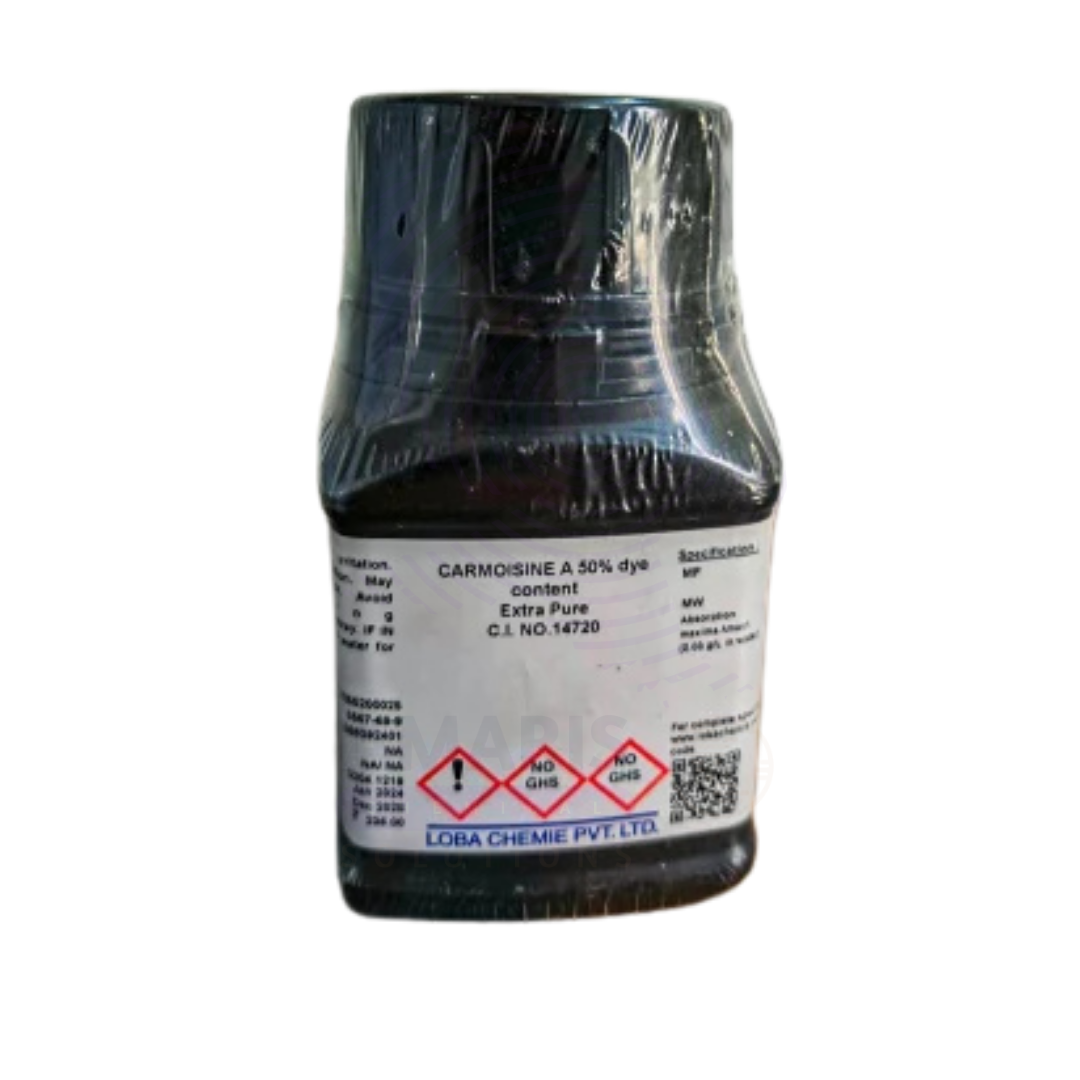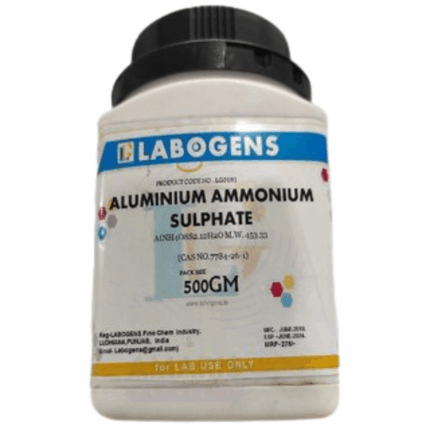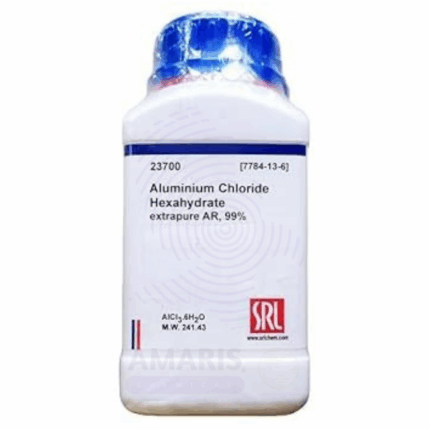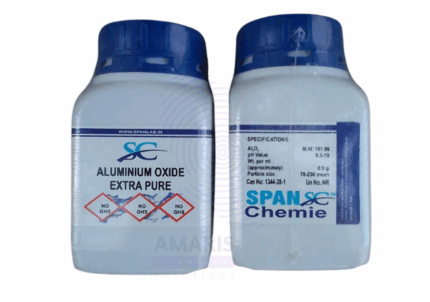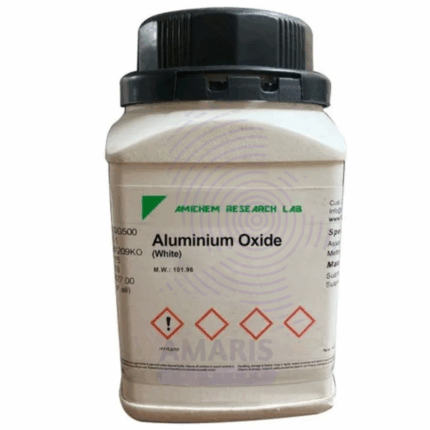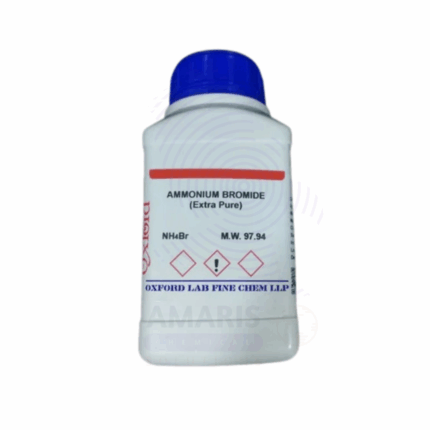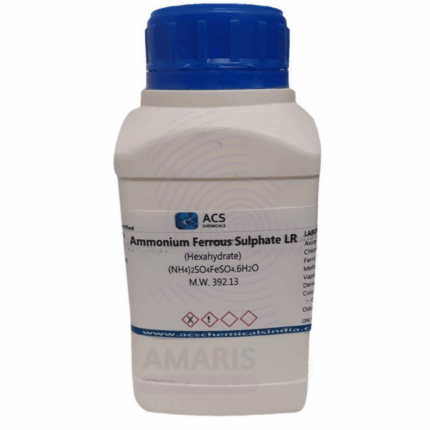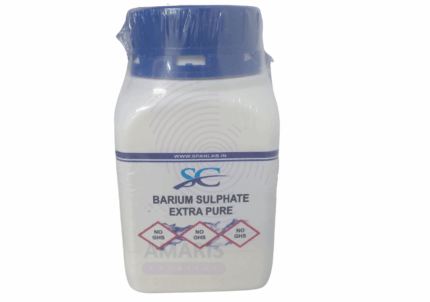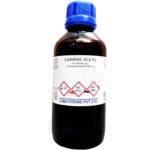
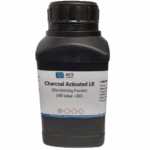
Carmoisine Red Extra Pure
$ 20.00 Original price was: $ 20.00.$ 19.38Current price is: $ 19.38.
Carmoisine Red Extra Pure is a high-purity synthetic azo dye widely used in laboratory settings for analytical and diagnostic applications, especially in colorimetric assays, pH studies, and chromatographic analysis. Known for its vibrant red hue and excellent solubility in water, it provides consistent and stable coloration under controlled conditions. In biochemical and pharmaceutical research, it serves as a model compound for dye interaction studies and compound tracing. The extra pure grade ensures low levels of impurities, offering high reliability in sensitive experimental work. It should be handled with care, stored in a cool, dry area, and protected from light to maintain its structural and color integrity.
Carmoisine Red Extra Pure
Primary Uses
- Colorimetric Indicator in Analytical Chemistry
- Used in qualitative analysis and colorimetric methods to track reaction endpoints, especially in dye-sensitized tests or pH-related color changes.
- Spectrophotometric Calibration and Research
- Employed as a standard dye in UV-Vis spectrophotometry for studying absorption spectra, dye behavior, and solubility dynamics.
- Model Compound in Dye Degradation Studies
- Acts as a test pollutant in photocatalysis and wastewater treatment research, helping evaluate removal efficiency of dyes using various lab methods (e.g. TiO₂ photocatalysts, Fenton reaction).
- Chromatography Practice & Separation Studies
- Used in paper and thin-layer chromatography training and method development, due to its vivid color and predictable migration.
Secondary Uses
- Educational Demonstration of Food Dye Behavior
- Serves as a demo reagent in school and university labs to show solubility, diffusion, and dye interactions.
- Standard for Dye Stability Tests
- Applied in experiments to test thermal and light stability of synthetic azo dyes.
- Toxicology and Allergenicity Research Models
- Occasionally used as a representative synthetic dye in in vitro assays exploring allergenic or toxic dye effects.
| PACK SIZE |
500 grams Plastic Tin |
|---|
1. Basic Identification Attributes
- Chemical Name: Carmoisine
- Grade: Extra Pure (Laboratory Grade)
- Type: Azo dye
- Chemical Formula: C20H12N2Na2O7S2
- CI Number: CI Food Red 3 / CI 14720
- CAS Number: 3567-69-9
- Synonyms: Azorubine, Acid Red 14, Food Red 3
2. Physical & Chemical Properties
- Appearance: Red to dark red powder or granules
- Solubility: Soluble in water; slightly soluble in ethanol
- Melting Point: Decomposes before melting
- Stability: Stable under normal lab conditions
- pH Range (in solution): Slightly acidic to neutral
3. Safety & Hazard Attributes
- Hazard Classification: Not classified as hazardous under GHS for lab quantities
- Hazard Statements:
- May cause mild skin, eye, or respiratory irritation in sensitive individuals
- Precautionary Measures:
- Avoid inhalation of dust
- Use with standard PPE
- Wash hands thoroughly after handling
4. Storage & Handling Attributes
- Storage Conditions:
- Store in a cool, dry, well-ventilated place
- Keep container tightly closed and protected from light
- Handling Precautions:
- Avoid creating or inhaling dust
- Prevent contamination with incompatible substances (oxidizers)
5. Regulatory & Compliance Attributes
- Transport: Not regulated for transport
- Waste Disposal: Dispose in accordance with local chemical waste regulations
- Regulatory Notes:
- Banned or restricted as a food additive in some countries
- Not for human consumption in laboratory settings
6. Environmental & Health Impact
- Toxicity: Low acute toxicity; high doses may have adverse effects in animals
- Health Effects:
- Potential allergen in susceptible individuals
- Environmental Hazard: May be harmful to aquatic life in large quantities
- Fumes/Dusts: Avoid breathing dust or aerosols in dry handling
SAFETY PRECAUTIONS
- Personal Protective Equipment (PPE):
- Wear lab coat, nitrile gloves, and protective goggles.
- Use a dust mask or work in a fume hood to avoid inhalation of airborne particles.
- Handling:
- Avoid contact with skin, eyes, and clothing.
- Prevent formation of dust and avoid breathing it in.
- Wash hands thoroughly after handling.
- Storage:
- Store in a cool, dry, and well-ventilated area.
- Keep the container tightly closed and protected from light.
- Avoid proximity to oxidizing agents and strong acids.
FIRST AID MEASURES
- Inhalation:
- Remove the person to fresh air.
- Seek medical attention if respiratory symptoms persist.
- Skin Contact:
- Wash with soap and plenty of water.
- Remove contaminated clothing.
- Get medical advice if irritation develops.
- Eye Contact:
- Rinse cautiously with water for several minutes.
- Remove contact lenses if present and easy to do.
- Continue rinsing and seek medical attention if irritation persists.
- Ingestion:
- Rinse mouth with water.
- Do not induce vomiting.
- Seek medical advice if symptoms occur.
FIRE FIGHTING MEASURES
- Flammability:
- Generally considered non-flammable, but fine dust may pose a combustible dust hazard in air.
- Extinguishing Media:
- Use dry chemical, CO₂, or foam.
- Water spray can cool surfaces but may spread dust.
- Hazardous Combustion Products:
- May emit carbon oxides and nitrogen oxides if decomposed in fire.
- Firefighter Protection:
- Use self-contained breathing apparatus (SCBA) and wear full protective gear.


 Preservatives(food)
Preservatives(food) Flavor Enhancers
Flavor Enhancers Acidulants
Acidulants Sweeteners
Sweeteners Antioxidants
Antioxidants Colorants(food)
Colorants(food) Nutraceutical Ingredients (food)
Nutraceutical Ingredients (food) Nutrient Supplements
Nutrient Supplements Emulsifiers
Emulsifiers
 Collectors
Collectors Dust Suppressants
Dust Suppressants Explosives and Blasting Agents
Explosives and Blasting Agents Flocculants and Coagulants
Flocculants and Coagulants Frothers
Frothers Leaching Agents
Leaching Agents pH Modifiers
pH Modifiers Precious Metal Extraction Agents
Precious Metal Extraction Agents
 Antioxidants(plastic)
Antioxidants(plastic) Colorants (Pigments, Dyes)
Colorants (Pigments, Dyes) Fillers and Reinforcements
Fillers and Reinforcements Flame Retardants
Flame Retardants Monomers
Monomers Plasticizers
Plasticizers Polymerization Initiators
Polymerization Initiators Stabilizers (UV, Heat)
Stabilizers (UV, Heat)
 Antifoaming Agents
Antifoaming Agents Chelating Agents
Chelating Agents Coagulants and Flocculants
Coagulants and Flocculants Corrosion Inhibitors
Corrosion Inhibitors Disinfectants and Biocides
Disinfectants and Biocides Oxidizing Agents
Oxidizing Agents pH Adjusters
pH Adjusters Scale Inhibitors( water)
Scale Inhibitors( water)
 Antioxidants(cosmetic)
Antioxidants(cosmetic) Emollients
Emollients Fragrances and Essential Oils
Fragrances and Essential Oils Humectants
Humectants Preservatives
Preservatives Surfactants(cosmetic)
Surfactants(cosmetic) Thickeners
Thickeners UV Filters
UV Filters
 Fertilizers
Fertilizers Soil Conditioners
Soil Conditioners Plant Growth Regulators
Plant Growth Regulators Animal Feed Additives
Animal Feed Additives Biostimulants
Biostimulants Pesticides (Herbicides, Insecticides, Fungicides)
Pesticides (Herbicides, Insecticides, Fungicides)
 Active Pharmaceutical Ingredients (APIs)
Active Pharmaceutical Ingredients (APIs) Excipients
Excipients Solvents(pharmaceutical)
Solvents(pharmaceutical) Antibiotics
Antibiotics Antiseptics and Disinfectants
Antiseptics and Disinfectants Vaccine Adjuvants
Vaccine Adjuvants Nutraceutical Ingredients (pharmaceutical)
Nutraceutical Ingredients (pharmaceutical) Analgesics & Antipyretics
Analgesics & Antipyretics
 Analytical Reagents
Analytical Reagents Solvents(lab)
Solvents(lab) Chromatography Chemicals
Chromatography Chemicals Spectroscopy Reagents
Spectroscopy Reagents microbiology-and-cell-culture-reagents
microbiology-and-cell-culture-reagents Molecular Biology Reagents
Molecular Biology Reagents Biochemical Reagents
Biochemical Reagents Inorganic and Organic Standards
Inorganic and Organic Standards Laboratory Safety Chemicals
Laboratory Safety Chemicals Specialty Laboratory Chemicals(Special Laboratory Equipment)
Specialty Laboratory Chemicals(Special Laboratory Equipment)
 Demulsifiers
Demulsifiers Hydraulic Fracturing Fluids
Hydraulic Fracturing Fluids Scale Inhibitors(oil)
Scale Inhibitors(oil) Surfactants(oil)
Surfactants(oil) Drilling Fluids
Drilling Fluids
 Dyes and Pigments
Dyes and Pigments Bleaching Agents
Bleaching Agents Softening Agents
Softening Agents Finishing Agents
Finishing Agents Antistatic Agents
Antistatic Agents
 Admixtures
Admixtures Waterproofing Agents
Waterproofing Agents Sealants and Adhesives
Sealants and Adhesives Curing Compounds
Curing Compounds Concrete Repair Chemicals
Concrete Repair Chemicals Anti-Corrosion Coatings
Anti-Corrosion Coatings
 Surfactants(cleaning)
Surfactants(cleaning) Builders
Builders Enzymes
Enzymes Solvents (Cleaning)
Solvents (Cleaning) Fragrances
Fragrances
 Electronic Chemicals
Electronic Chemicals Catalysts
Catalysts Lubricants
Lubricants Photographic Chemicals
Photographic Chemicals Refrigerants
Refrigerants Automotive chemicals
Automotive chemicals Pyrotechnic Chemicals
Pyrotechnic Chemicals
 Biodegradable Surfactants
Biodegradable Surfactants Bio-based Solvents
Bio-based Solvents Renewable Polymers
Renewable Polymers Carbon Capture Chemicals
Carbon Capture Chemicals Wastewater Treatment Chemicals
Wastewater Treatment Chemicals
 Pigments
Pigments Solvents(paint)
Solvents(paint) Specialty Coatings
Specialty Coatings Binders/Resins
Binders/Resins Additives
Additives Driers
Driers Anti-Corrosion Agents
Anti-Corrosion Agents Functional Coatings
Functional Coatings Application-Specific Coatings
Application-Specific Coatings
 Fresh Herbs
Fresh Herbs Ground Spices
Ground Spices Whole Spices
Whole Spices Spice Blends
Spice Blends Dried Herbs
Dried Herbs
 Leavening Agents
Leavening Agents Dough Conditioners
Dough Conditioners Flour Treatments
Flour Treatments Fat Replacers
Fat Replacers Decoratives
Decoratives Preservatives(baking)
Preservatives(baking)
 Plasticizers & Softeners
Plasticizers & Softeners Reinforcing Agents
Reinforcing Agents Adhesion Promoters
Adhesion Promoters Vulcanizing Agents
Vulcanizing Agents Antidegradants
Antidegradants Blowing Agents
Blowing Agents Fillers & Extenders
Fillers & Extenders Accelerators & Retarders
Accelerators & Retarders